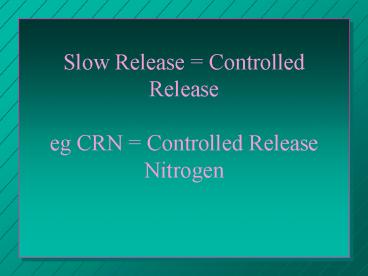Slow Release = Controlled Release eg CRN = Controlled Release Nitrogen PowerPoint PPT Presentation
1 / 29
Title: Slow Release = Controlled Release eg CRN = Controlled Release Nitrogen
1
Slow Release Controlled Releaseeg CRN
Controlled Release Nitrogen
2
Why Use Slow Release Fertilizers?
- More uniform growth response
- No growth surge
- Longer growth response
- Less chance of burn
- Less leaching of nitrate
- Labor saving
3
Uncoated Slow Release Fertilizers
- Urea formaldehyde (UF)
- Methylene urea (MU)
- Isobutylidene diurea (IBDU)
- Natural organics
4
Ureaform and Methylene Urea
- Very similar materials chemically
- Mostly granular, some liquids
- about 40 N, 70 WIN (28 N for liquids, all
soluble) - Formed by reacting urea and formaldehyde chains
of alternating C and N - Main difference is chain length, and as a result,
mineralization rate
5
Products
- Formolene 30-0-2
- FLUF 18-0-0
- Nitro 26 CRN 26-0-0
- Nitroform (Powder Blue, Blue Chip) 38-0-0
- CoRoN 28-0-0 (25 of total N is urea)
6
Different Chain Lengths
7
Ureaform and Methylene Urea
- Designed to release N for 8-12 weeks
- Contains unreacted urea, fast greening
- Requires soil microbial activity
- temperature sensitive, soil at 78o F is four
times as active as soil at 42o F - moisture sensitive
- Seasonal response
8
Mineralization
- The decomposition of complex, N-containing
organic molecules and the resulting release of NH4
9
MU, UF Chain Length Determines SolubilityThe
longer the chain, the less soluble it is, and the
slower it will be mineralized. Some may be so
long that they are essentially insoluble, and
wont break down.
10
N Release from UF, MU Determined by Solubility
Test
- Water soluble vs Water insoluble fractions
- CWSN, cold water soluble N, is soluble at 25o C,
is quickly available to the turf. Includes
unreacted urea and short chain molecules - CWIN, cold water insoluble N. What remains
insoluble at 25o C. Longer chain, N is released
slower, over a period of several weeks - HWIN, N insoluble at 100o C. Longest chain, N
released over months or years
11
How Much Dissolves at 25o C?
100 grams CRN in
71 grams out
Stir
100 - 71 29 grams (29) CWSN and 71 grams
(71) CWIN
12
How Much Dissolves at 100o C?
71 grams CRN in
22 grams out
Stir
Thus, in 100 g of CRN, there are 22 g HWIN
13
Activity Index, AI
- Basically the fraction of CWIN that goes into
solution in hot water. It estimates the
slow-release value of the fertilizer - CWIN - HWIN CWIN
- Fertilizers with a higher AI have increased N
solubility, better slow-N release
characteristics. - UF should have an AI of gt 40
X 100
14
Summary
- CWSN - 29
- CWIN - 71
- HWIN - 22
- Activity Index CWIN - HWIN
CWIN 71 - 22 71
X 100
X 100 69
15
CRN Sources VaryWhich Will Give Longer Response?
36 HWIN
71 HWIN
Formolene 38-0-0
Nutralene 40-0-0
51 CWIN
18 CWIN
Both from Agrevo
13 urea
11 urea
16
WSN vs WIN
- WIN must be stated on label
- Expressed as of the product, not the nitrogen
- Example FLUF contains 18 N, and 4.5 WIN. This
means that 18-4.513.5 of the N is WSN. What
of the N is WIN? 4.5/1825
17
IBDU
- Urea is reacted with isobutyraldehyde
- Only a single chemical product is formed, not a
bunch of different molecules. 31 N, 90 WIN - Different sized granules available
- N release depends on solubility and hydrolysis
(IBDU molecule reacts with water and breaks
apart), releasing urea. - No free urea in IBDU, may need to add
18
IBDU start here
- Urea breaks down quickly to NH4
- IBDU is relatively insoluble, so only small
amounts are available at any one time - Release sensitive to soil moisture, temperature
- Release also depends on granule size and contact
with soil. Smaller granules release N faster
than larger granules
19
Liquid Slow Release Fertilizers
- Chemistry similar to UF, MU
- Micro-suspension of MU (FLUF)
- CoRoN, N-Sure 28N, 7 as urea and 21 as short
chain MU or small ring structure. - Get quick and slow release
- Foliar application?
- Is slow release slow enough?
20
Liquid Slow Release Fertilizers
- Easily handled, applied
- Can be formulated with P and K
- Some have short storage life
- Require specialized delivery system
- Volume of liquid used in application is not
enough to move the material down into the root
system - must irrigate in
21
Coated Slow Release Fertilizers
- SCU, sulfur coated urea
- Polymer coated urea
22
Sulfur Coated Urea
- Solid urea core, coated with sulfur and wax
- 30-38 N, depending on coating thickness
- Coating is not always perfect, having cracks,
thin spots, holes, etc. - Release determined by 7 day dissolution test
25-35 are typical figures
23
Polymer Coated Urea
- Solid urea or other nutrient core, coated with
various polymers (plastics) - Coatings are tough, resist damage, thin
- Coating chemistry affects membrane properties,
release rate - Release is due to controlled diffusion, which is
fairly constant over time - Release depends on coat thickness, chemistry,
temperature, moisture
24
Polymer Coatings Remain Intact
Water
Dissolved Urea
Water
Dissolved Urea
Complete Release
Dissolved Urea
Or other nutrient
25
Sulfur Coatings Break Down
Sulfur Coating
Solid Urea
Solid Urea
H2O
Dissolved Urea
26
SCU Contains Intact and Breached Particles, Thin
and Thick Coatings
27
IBDU Releases N Based on Solubility
H2O
Urea
Urease
NH4
Root
28
Release Depends on Granule Size
29
Small Granules Release Faster, Shorter

